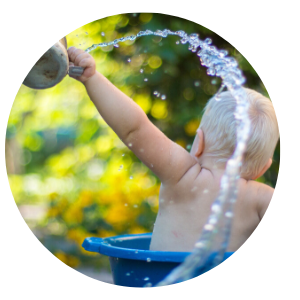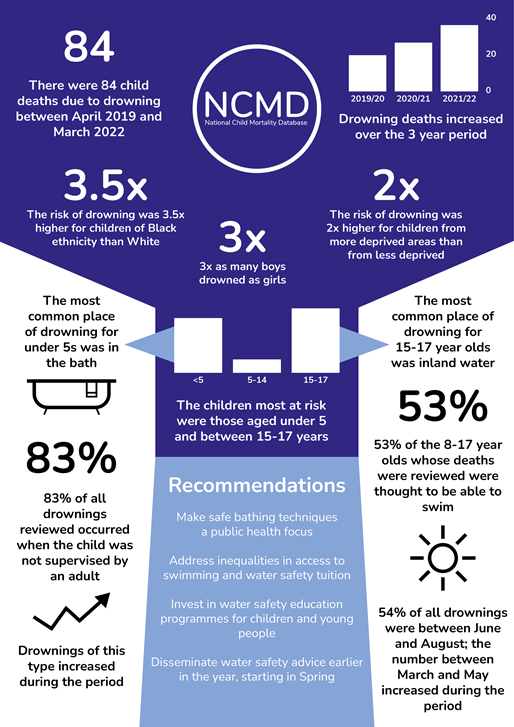Water Safety for younger children
Drowning happens silently. A drowning child can’t speak or control their arms. It’s only in the movies they splash about and cry for help.
 Baths - At home, younger children are most likely to drown in the bath or garden pond. There may be no warning that something is wrong, as babies drown silently in as little as 5 cm of water.
Baths - At home, younger children are most likely to drown in the bath or garden pond. There may be no warning that something is wrong, as babies drown silently in as little as 5 cm of water.
- A baby should never be left alone even for a moment
- Bath seats are not float aids
- Get everything you need ready before bath time so you're not tempted to nip to grab anything
- Don’t rely on your toddler to keep an eye on the baby as they’re still too young to understand danger.
Paddling Pools and Ponds - Drain paddling pools when not in use and cover hot tubs and garden ponds securely if fencing isn’t an option.
- Empty the paddling pool out after you’ve used it
- Turn a pond into a sandpit, or fence it in or cover it while your children are little
- Make sure your child can’t get to the neighbour’s pond
- Be alert to ponds or pools when visiting other people’s homes
- Ensuring fencing is used around residential swimming pools
.
Water Safety for Older Children
As children become older and possibly stronger swimmers, it’s important to educate them about water safety. They may still lack the strength and skills to get themselves out of trouble if they find themselves in strong currents or deep water, or discover too late dangerous objects lurking in the water.
- Teach older children to choose safe places to swim like public pools and beaches with lifeguards
- Explain the dangers of swimming in open water, including strong currents, deep, cold water and things under the surface they can’t see.
At the beach - Swimming in an open body of water, like the sea is different from swimming in a pool. More energy is needed to handle the currents and other changing conditions in the open water.
If you do find yourself caught in a current, don't panic and don't fight the current. Try to swim parallel to the shore until you are able to get out of the current.
- Teach children to swim between the red and yellow flags – these mark the areas patrolled by lifeguards
- Inflatables can be swept out to sea when the wind is blowing – keep children off inflatables when the orange windsock is flying and always keep an eye on them
- Buddy up - when people swim together, they can help each other or go for help in case of an emergency.
More information on water safety by the sea can be found on the RNLI Respect the Water webpages.
Tombstoning - Tombstoning is a high-risk, high-impact experience that can have severe and life-threatening consequences. This is because:
- Water depths alter with the tide – the water may be shallower than it seems
- Submerged objects like rocks may not be visible – these can cause serious impact injuries
- The shock of cold water can make it difficult to swim
- Getting out of the water is often more difficult than people realise
- Strong currents can rapidly sweep people away
More information on tombstoning can be found on the RoSPA website.

 Baths - At home, younger children are most likely to drown in the bath or garden pond. There may be no warning that something is wrong, as babies drown silently in as little as 5 cm of water.
Baths - At home, younger children are most likely to drown in the bath or garden pond. There may be no warning that something is wrong, as babies drown silently in as little as 5 cm of water.